
Original Link: https://www.anandtech.com/show/1149
Intel Developer Forum Fall 2003 – Day 1: Otellini's Keynote
by Derek Wilson on September 16, 2003 4:27 PM EST- Posted in
- IT Computing
It's another Fall and we're met with yet another Intel Developer Forum. Although a bit shortened this year, we're still expecting the usual amount of information to flow our way. Things started off on a bit quicker of a pace with the opening keynote by Paul Otellini, which you will hear about in the coming pages.
We heard quite a bit about Intel's plans for threading with things like Hyper Threading, dual and multi-core CPUs in the desktop, workstation and server markets. You'll also learn about LaGrande, Intel's secure computing technology as well as Vanderpool technology, which we found quite interesting.
Expect to hear lots more about Prescott , Dothan and maybe even Grantsdale as we make our way through the days of IDF.
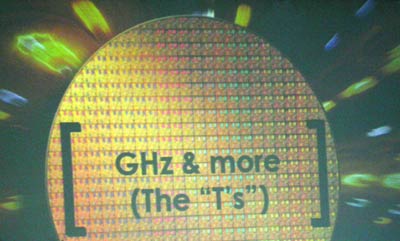
The “T”s
Even from the very beginning of the keynote, Paul Otellini made it very clear that Intel's current and future focus is firmly planted on end user experience. No longer will the microprocessor giant's focus be showing off higher and higher GHz machines (although we'll still see faster CPUs released of course). Instead we were presented with a multitude of technologies (that Intel lovingly called the “T”s) centered around enhancing the end user's experience. Much of the information we have already heard, but there were some interesting surprises as well.
The first of the “T”s Intel covered was Hyper Threading. Intel sees the adoption of HT rising to 50% of the market in the not so distant future, and we were shown a few graphs of the enhancements HT provides in multithreading and multitasking. As you can tell, most of this has been said before, but there were some very exiting revelations made. It seems that with the speed desktop users have embraced HT, Intel has decided that it is well worth their time to bring dual core processors to the desktop.
Multicore architectures coming to the desktop is very good news for computer users everywhere, and we are very exited about the possibilities of pervasive multiprocessing support. We definitely didn't expect such an early commitment to bringing this technology to the desktop, so this was quite a plesant surprise.
Intel's first dual-core CPU will by the Itanium followup known as Montecito, which will also be the first CPU from Intel to feature a total of 1 billion transistors. The follow-on to Montecito will be Tanglewood, the first multicore Itanium processor (meaning more than two cores on one die). Intel did not reveal if either of these processors would have Hyper Threading support, which many have speculated would be perfect for the Itanium architecture.
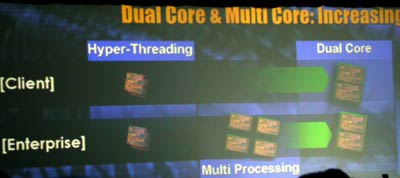
Intel went on to reveal that the Xeon would receive a dual core version with the Tulsa core (due out after Potomac ). Like its predecessors, Tulsa will also feature Hyper Threading technology meaning that each of the two cores would appear as two CPUs to the OS. Given the close relationship we've seen between Xeon processors and the Pentium 4 desktops, it would be safe to assume that a dual core desktop CPU would be due out either around the same time as Tulsa or slightly later. Given the increased transistor count of Tulsa (twice as much as a single core CPU obviously, assuming they don't share caches), we may see a desktop introduction delayed a bit due to the price sensitivity of the desktop market.
The second “T”, Centrino Mobile Technology (CMT), is alive and well, but Intel didn't spend much time talking about CMT. We will undoubtedly hear more about Centrino in Anand Chandrasehker's keynote on Wednesday, but until then we were left with a brief demo of Dothan (90nm Pentium-M with 2MB L2 cache) on a Samsung laptop.
Afterwards, they quickly moved on to their third “T”, LaGrande Technology. While Intel has previously mentioned LaGrande, this time we got a demo. While the acting abilities of the Intel staff need a little work, the technology looks very cool. The premise of the demo was keeping a hacker from being able to access information even after he has breached the users system. For instance, using LT combined with future Microsoft secure operating system technology, “secure” windows can pop up that aren't accessible via framebuffer grabbers.
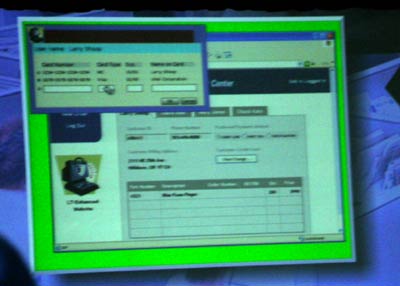
LaGrande in action
The same goes for the keyboard buffer, so it's not possible to sniff out what the user types. Even if the hacker does a full memory dump, Intel made it sound like memory was made to have less special associativity. In other words, when the name of someone is next to a credit card number on the screen, the credit card number is somewhere else in memory that cannot be reached (as easily).
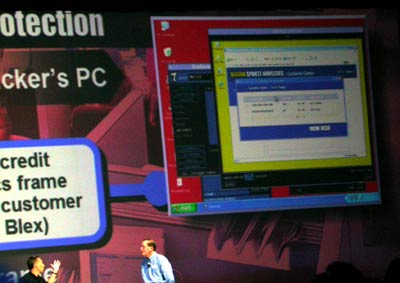
When LaGrande was first announced, there was a bit of an uproar about privacy protection, which Otellini addressed in this keynote. Users will be able to enable/disable LaGrande technology at the hardware level if they would like, and we wouldn't have it any other way.
By far the most interesting “T” Intel presented was Vanderpool Technology. Our enterprise users may be familiar with similar technology running on large scale supercomputers, and those linux users out there who want to run windows in a window via VMWare will also have a grasp of this.
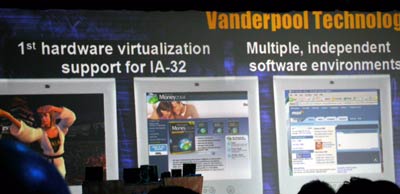
Essentially, Vanderpool Technology is hardware virtualization for the desktop – allowing multiple users to use the same PC as if it were multiple PCs. The fact that this is a hardware implementation gives Intel a huge leg up on software like VMWare though. During Intel's demo of VT hardware, one user was able to watch a dvd while the other played a game, and even rebooted the computer and installed drivers, without interrupting the first. This technology enables a plethora of options that could really assist Intel in their digital home focus. This is one very good use for the incredible power today's desktop microprocessors are given, since you could buy one 4GHz PC and share its power among multiple independent users, each with their own OS, drivers and programs.
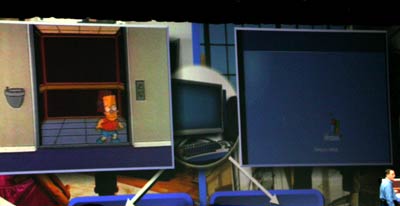
MXP5800
Intel also demoed a programmable media processor called the MXP5800. The demo consisted of very cheesy video effects being run in realtime on a feed from someone taping Pat Gelsinger's head. Even though the demo was a little lack luster, the uses for which a programmable realtime hardware media processing solution are virtually limitless. This is definitely something users of sound and video editing programs will want to get their hands on when it makes its way into the consumer market.
Intel likes Silicon
And what would an IDF be without some time devoted to Moore 's law and silicon technology?
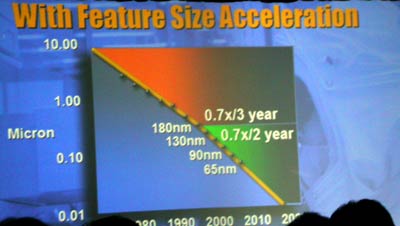
Well, luckily we don't have to answer that as we were reveled with wonderful stories of strained silicon and the history and future of silicon semiconductors. The mandatory mention of Moore 's law and its limitations were followed up by a quote form Mr. Moore himself that essentially said that even if we can't beat the end of Moore's law, we can delay it for a while. And it seems that their game plan is going pretty well as they are looking at moving to a 22nm manufacturing process by 2010. Intel showed us a wafer fabbed using a 65nm process (targeted at 2005), and their 45nm research is being enhanced by trigate transistors (where the sides of the gate are used in addition to the top).
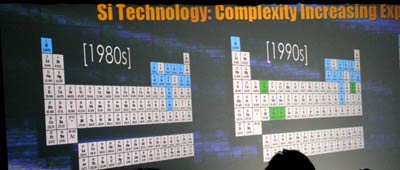
Enterprise: That's a lot of Itaniums
Our enterprise readers may be interested in the sgi Altix 3700 demo we saw. The Altix 3700 is a 128 way Itanium 2 computer running Linux. We were able to see a demo of Intel running some fluid dynamics simulations on F1 cars driving at 200 MPH. Apparently where “other” computers take a week to run the sim, the 3700 can do it in under a day.
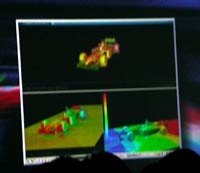
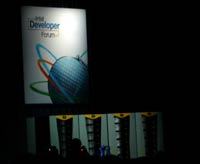
Intel's commitment to Itanium technology was reiterated, and they spoke briefly about Montecito (dual core Itanium) and Tanglewood (multi core Itanium). The latter of which will be the first processor worked on by the design team Intel acquired from Alpha and will offer 7 times the performance of the current Madison cores.
Home: What up DHWG
Convergence and the digital home were touched on at the end of the keynote, and Intel revealed DHWG (digital home working group pronounced - dawg) that will be making sure the digital home is interoperable. The only really useful thing to mention from this section of the key note is DTCP/IP (digital transmission content protection over ip). DTCP/IP is a protocol that allows for secure wireless transmission within the home.
Details weren't really revealed, but we did see a demo that showed off the functionality via a wireless streaming of the Animatrix. Of course this was properly interrupted by time warner for a brief note that they support anything that helps stop piracy.
Final Words
With the first keynote of the day, the Fall 2003 Intel Developer Forum has begun. In order to drum up more interest and fewer complaints about the show, Intel has reduced its length to three days and introduced the concept of afternoon keynotes – one of which we will be attending later today.
For now, it's off to speak with Bill Siu, Intel's VP and GM of Desktop about Intel's plans for the computing world…







